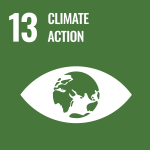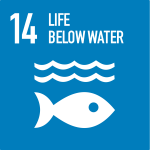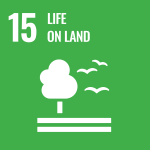Relationship (correlation) between measured (historical data) air quality parameters and weather parameters using statistical tool (Canonical Correlation Analysis: CCA, explained in detailed in About Data). This approach assists in examining change of the modelled future climate affect the air quality in the Peninsular Malaysia. This method helps to identify and narrow down the important variables for both sides for the best predictors.
The data has shown two important information: the correlation and the variance. The higher correlation indicate the close relationship between weather and air quality condition, while the higher variance explained the confidence of such correlation. Both of this information has to be read together for the interpretation of the result.
The green map indicates the correlation strength between weather and air quality parameters, the greener the stronger. While the orange/brown map represents the strength of variables explaining the correlation, the browner the higher confidence of the correlation.
The dataset hence shown that the west coast of Peninsular Malaysia demonstrated a higher correlation and confidence of the sensitivity of air pollution condition to the changing climate in the future.
The historical dataset (2000 – 2019) used for air quality (CO, O3, SO2, NO2, PM10) and weather (Temperature and humidity) is collected from the selected stations operated by the Department of Environment (DOE) Malaysia while the historical dataset (2000 – 2019) used for rainfall collected from the selected stations operated by the Met Malaysia.
The canonical correlation analysis (CCA) is conducted on a regional level to determine the level of correlation between the climate and air quality. Taking states as the main basis for distinction, the states of the Peninsular are restructured into eight regions, as shown above. An independent CCA study was conducted for each region using the station data within the region. The future prediction and simulation of the air quality is carried out using a machine learning-based algorithm from the scikit-learn library in Python.
| TEMPORAL COVERAGE | : | 2000-2019 for current CCA analysis |
| TEMPORAL FREQUENCY | : | Yearly |
| SPATIAL COVERAGE | : | Peninsular Malaysia |
| SPATIAL RESOLUTION | : | – |
| VARIABLES | : | Temperature (◦ C) , Relative Humidity (%) , Concentrations of Particulate Matter (PM10), Ozone (O3), Carbon Monoxide (CO), Nitrogen Dioxide (NO2), and Sulfur Dioxide (SO2) |
Zheng, Y., Ooi, M.C.G., Juneng, L., Wee, H.B., Latif, M.T., Nadzir, M.S.M., Hanif, N.M., Chan, A., Li, L., Ahmad, N., Tangang, F. (2023) Assessing the impacts of climate variables on long-term air quality trends in Peninsular Malaysia, Science of the Total Environment, 901(166430), https://doi.org/10.1016/j.scitotenv.2023.166430
| CONTACT PERSON | : | Dr. Maggie Ooi Chel Gee (Profile) |
| FUNDING INFORMATION | : | The Ministry of Higher Education Malaysia for supporting this research through Long-term Research Grant Scheme Project 3, grant number LRGS/1/2020/UKM–UKM/01/6/3, which is under the program of LRGS/1/2020/UKM/01/6. https://www.ukm.my/globwarm/ |
| REFERENCE | : | The Department of the Environment Malaysia and the Malaysia Meteorological Department We would like to thank the |






